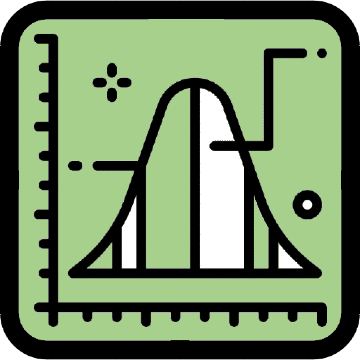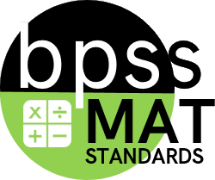MAT-01.DPS  MAT-01.DPS MAT-01.DPS Domain  | (DPS) Data Probability and Statistics Learners will ask and answer questions by collecting, organizing, and displaying
relevant data, drawing inferences and conclusions and making predictions; and understanding and applying basic concepts of probability.
|
Sub-Categories- (D) Data
Learners will represent and interpret data. - (DA) Data Analysis
Learners will ask and answer questions by collecting, organizing, and displaying relevant data, drawing inferences and conclusions, and making predictions. - (P) Probability
Learners will understand and apply basic concepts of probability.
Calculation Method for DomainsDomains are larger groups of related standards. The Domain Grade is a calculation of all the related standards. Click on the standard name below each Domain to access the learning targets and rubrics/ proficiency scales
for individual standards within the domain. |
|
MAT-01.DPS.D.01

|
1st Grade (MAT) Targeted Standard
(DPS) Data Probability and Statistics
(D) Data
Learners will represent and interpret data.
|
MAT-01.DPS.D.01 Collect, organize and represent data with up to three categories using picture and bar graphs.
 Proficiency Scale Proficiency Scale
Progressions
Data Collection
- MAT-00.DPS.D.01 Sort and classify objects (up to 10) based on attributes and explain the reasoning used.
- MAT-01.DPS.D.01 Collect, organize and represent data with up to three categories using picture and bar graphs.
- MAT-02.DPS.D.01 Formulate questions and collect, organize, and represent data, with up to four categories using single unit scaled pictures and bar graphs.
- MAT-03.DPS.D.01 Formulate questions to collect, organize, and represent data with more than four categories using scaled pictures and bar graphs.
- MAT-04.DPS.D.01 Formulate questions to collect, organize, and represent data to reason with math and across disciplines.
- MAT-06.DPS.DA.01 Write a statistical question that can be answered using measures of center or variability of a data set.
- MAT-07.DPS.DA.01 Identify the strengths and weaknesses of a population sample, including possible bias in the process of the data collection.
- MAT-12.DPS.06 Use data from a sample survey to estimate a population means or proportion; develop a margin of error through the use of simulation models for random sampling.
- MAT-12.DPS.09 Recognize the purposes of and differences among sample surveys, experiments, and observational studies; explain how randomization relates to each.
Displaying Data
- MAT-01.DPS.D.01 Collect, organize and represent data with up to three categories using picture and bar graphs.
- MAT-02.DPS.D.01 Formulate questions and collect, organize, and represent data, with up to four categories using single unit scaled pictures and bar graphs.
- MAT-03.DPS.D.01 Formulate questions to collect, organize, and represent data with more than four categories using scaled pictures and bar graphs.
- MAT-04.DPS.D.01 Formulate questions to collect, organize, and represent data to reason with math and across disciplines.
- MAT-02.DPS.D.02 Generate data and create line plots marked in whole number units.
- MAT-03.DPS.D.02 Generate data and create line plots marked in whole numbers, halves, and fourths of a unit.
- MAT-04.DPS.D.02 Generate data and create line plots to display a data set of fractions of a unit (1/2, 1/4, 1/8). Solve problems involving addition and subtraction of fractions by using information presented in line plots.
- MAT-05.DPS.D.01 Generate data and create line plots to display a data set of fractions of a unit (1/2, 1/4, 1/8). Use grade-level operations for fractions to solve problems involving information presented in line plots.
- MAT-06.DPS.DA.04 Display numerical data in plots on a number line, including dot plots and histograms. Describe any overall patterns in data, such as gaps, clusters, and skews.
- MAT-09.NO.03 Choose and interpret the scale and the units in graphs and data displays.
- MAT-09.NO.05 Choose a level of accuracy or precision appropriate to limitations on measurement when reporting quantities.
- MAT-10.DPS.01 Represent data with plots on the real number line (dot plots, histograms, and box plots).
- MAT-10.DPS.03 Represent data on two quantitative variables on a scatter plot and describe how the variables are related.
- MAT-10.DPS.10 Construct and interpret two-way frequency tables of data for two categorical variables. Use the two-way table as a sample space to decide if events are independent and approximate conditional probabilities.
- MAT-12.NO.04 Use units as a way to understand problems and to guide the solution of multi-step problems (e.g., unit analysis). Choose and interpret units consistently in formulas. Choose and interpret the scale and the units in graphs and data displays.
- MAT-12.DPS.04 Represent data on a scatter plot for two quantitative variables and describe how the variables are related.
|
|
MAT-01.DPS.D.02

|
1st Grade (MAT) Targeted Standard
(DPS) Data Probability and Statistics
(D) Data
Learners will represent and interpret data.
|
MAT-01.DPS.D.02 Analyze data by answering descriptive questions.*
 Proficiency Scale Proficiency Scale
Progressions
Data Analysis
- MAT-01.DPS.D.02 Analyze data by answering descriptive questions.
- MAT-02.DPS.D.03 Analyze data and interpret the results to solve one-step comparison problems using information from the graphs.
- MAT-03.DPS.D.03 Analyze data and make simple statements to solve one- and two-step problems using information from the graphs.
- MAT-04.DPS.D.02 Generate data and create line plots to display a data set of fractions of a unit (1/2, 1/4, 1/8). Solve problems involving addition and subtraction of fractions by using information presented in line plots.
- MAT-04.DPS.D.03 Utilize graphs and diagrams to represent and solve word problems using the four operations involving whole numbers, benchmark fractions, and decimals.
- MAT-05.DPS.D.01 Generate data and create line plots to display a data set of fractions of a unit (1/2, 1/4, 1/8). Use grade-level operations for fractions to solve problems involving information presented in line plots.
- MAT-05.DPS.D.02 Utilize graphs and diagrams to represent, analyze, and solve authentic problems using information presented in one or more tables or line plots, including whole numbers, fractions, and decimals.
- MAT-06.DPS.DA.02 Calculate measures of center (median and mean) and variability (range and mean absolute deviation) to answer a statistical question. Identify mode(s) if they exist.
- MAT-06.DPS.DA.03 Identify outliers by observation and describe their effect on measures of center and variability. Justify which measures would be appropriate to answer a statistical question.
- MAT-06.DPS.DA.04 Display numerical data in plots on a number line, including dot plots and histograms. Describe any overall patterns in data, such as gaps, clusters, and skews.
- MAT-07.DPS.DA.02 Analyze and draw inferences about a population using single and multiple random samples by using given measures of center and variability for the numerical data set.
- MAT-08.DPS.DA.01 Interpret scatter plots for bivariate measurement data to investigate patterns such as clustering, outliers, positive or negative association, linear association, and nonlinear association.
- MAT-08.DPS.DA.02 Draw a trend line on a given scatter plot with a linear association and justify its fit by describing the closeness of the data points to the line.
- MAT-08.DPS.DA.03 Solve authentic problems in the context of bivariate measurement data by interpreting the slope and intercept(s) and making predictions using a linear model.
- MAT-08.DPS.DA.04 Construct and interpret a two-way table summarizing bivariate categorical data collected from the same subjects.
- MAT-10.DPS.02 Compare the center (median, mean) and spread (interquartile range, standard deviation) of two or more different data sets using statistics appropriate to the shape of the data distribution.
- MAT-10.DPS.03 Represent data on two quantitative variables on a scatter plot and describe how the variables are related.
- MAT-10.DPS.04 Distinguish between correlation and causation.
- MAT-10.DPS.10 Construct and interpret two-way frequency tables of data for two categorical variables. Use the two-way table as a sample space to decide if events are independent and approximate conditional probabilities.
- MAT-12.DPS.01 Interpret differences in shape, center, and spread in the context of the data sets, accounting for possible effects of extreme data points (outliers).
- MAT-12.DPS.02 Use the mean and standard deviation of a data set to fit it to a normal distribution and estimate population percentages. Recognize that there are data sets for which such a procedure is not appropriate.
- MAT-12.DPS.03 Evaluate reports based on data.
- MAT-12.DPS.04 Represent data on a scatter plot for two quantitative variables and describe how the variables are related.
- MAT-12.DPS.05 Informally assess the fit of a function by plotting and analyzing residuals.
- MAT-12.DPS.06 Use data from a sample survey to estimate a population means or proportion; develop a margin of error through the use of simulation models for random sampling.
- MAT-12.DPS.07 Understand the process of making inferences about population parameters based on a random sample from that population.
- MAT-12.DPS.08 Decide if a specified model is consistent with results from a given data-generating process (e.g., using simulation).
|
|


